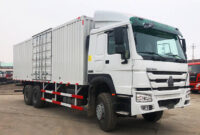7.3 Diesel Trucks For Sale By Owner: Your Ultimate Buying Guide pickup.truckstrend.com
In the world of heavy-duty pickup trucks, few engines command the respect and admiration that the Ford 7.3L Power Stroke diesel does. Produced from mid-1994 to early 2003, this venerable V8 has earned a legendary reputation for its unwavering reliability, mechanical simplicity, and sheer pulling power. For many, a 7.3 Power Stroke isn’t just a truck; it’s a legacy, a workhorse, and a testament to an era of straightforward, robust engineering.
While dealerships often have a selection of used trucks, many enthusiasts and budget-conscious buyers turn their attention to "For Sale By Owner" (FSBO) listings when hunting for a 7.3. This approach can offer unique advantages, from potential cost savings to direct insights into a vehicle’s history. However, it also comes with its own set of challenges that savvy buyers must navigate. This comprehensive guide will equip you with the knowledge and strategies to confidently find, inspect, and purchase your next 7.3 Power Stroke diesel truck directly from its owner.
7.3 Diesel Trucks For Sale By Owner: Your Ultimate Buying Guide
The Enduring Appeal of the 7.3 Power Stroke
The 7.3L Power Stroke, formally known as the Navistar T444E engine, became the backbone of Ford’s Super Duty lineup for nearly a decade. Its enduring popularity stems from several key attributes:
- Unrivaled Durability: Known for routinely reaching 300,000, 400,000, and even 500,000 miles with proper maintenance, the 7.3’s cast-iron block and robust internals are built to last.
- Mechanical Simplicity: Compared to modern diesel engines burdened with complex emissions systems (DPF, DEF, advanced EGR), the 7.3 is a breath of fresh air. Its Hydraulically Actuated Electronically Controlled Unit Injector (HEUI) system is relatively straightforward, making it more accessible for DIY repairs and less prone to costly emissions-related failures.
- Performance Potential: While not the most powerful in stock form by today’s standards, the 7.3 responds exceptionally well to aftermarket tuning and upgrades, easily achieving significant power and torque gains.
- Pre-Emissions Era: The absence of the aforementioned complex emissions equipment means fewer sensors to fail, no regeneration cycles, and generally lower long-term maintenance costs associated with emissions compliance.
- Versatility: From heavy towing and hauling to off-road adventures and daily commuting, the 7.3 Power Stroke excels as a versatile workhorse, embodying the "Built Ford Tough" ethos.

Why Consider Buying "By Owner"?
Opting for an FSBO purchase of a 7.3 Power Stroke can be a rewarding experience for several reasons:
- Potential Cost Savings: Without dealership overhead, markups, and reconditioning costs, private sellers often list their trucks at more competitive prices. This can translate into significant savings for the buyer.
- Direct Communication and History: You get to speak directly with the person who has owned and driven the truck. This direct interaction can provide invaluable insights into its maintenance history, common quirks, recent repairs, and how it was used. This transparency is rarely available at a dealership.
- Negotiation Flexibility: Private sellers are often more flexible on price and terms, especially if they are motivated to sell quickly. You have more room to negotiate based on your findings during inspection.
- No Pressure Sales: The typical high-pressure sales tactics found in dealerships are absent, allowing you to take your time, inspect the vehicle thoroughly, and make an informed decision without feeling rushed.

Navigating the Challenges of a "By Owner" Purchase

While attractive, buying FSBO isn’t without its caveats. Being aware of these challenges is crucial for a successful transaction:
- "As-Is" Sales: The vast majority of private sales are "as-is," meaning once you buy it, any issues that arise are your responsibility. There’s no warranty or recourse. This underscores the importance of a meticulous pre-purchase inspection.
- Lack of Financing Options: Private sellers typically require cash or a pre-approved personal loan. Dealerships, on the other hand, offer in-house financing options.
- Risk of Misrepresentation or Scams: While most private sellers are honest, there’s always a risk of encountering individuals who misrepresent the truck’s condition, hide issues, or even attempt outright scams (e.g., title washing, odometer fraud). Vigilance and verification are key.
- No Dealer Support: You won’t have the post-sale support or limited warranties that some dealerships might offer, even on older vehicles.
The Critical Pre-Purchase Inspection: What to Look For
This is arguably the most crucial step in an FSBO purchase. Assume nothing and inspect everything.
-
Engine (The Heartbeat):
- Cold Start: Arrange to see the truck when the engine is cold. Listen for excessive cranking, rough idle, or unusual noises. Some white smoke is normal on a cold diesel, but excessive or blue smoke indicates issues.
- Oil Leaks: Inspect around the valve covers, High-Pressure Oil Pump (HPOP), front cover, and oil cooler for leaks. The HPOP lines are common leak points.
- Fluids: Check oil (dark is normal, but shouldn’t smell burnt or be milky), coolant (should be clear, not sludgy or oily), and transmission fluid (red, not brown or burnt-smelling).
- Turbo: Listen for the turbo spooling up during acceleration. Check for excessive shaft play by trying to move the compressor wheel (a tiny bit of in-and-out play is okay, side-to-side is not).
- Exhaust Gas Recirculation (EGR) Valve (if applicable): Some early 7.3s had a very basic EGR system. Later ones didn’t have one until the 6.0L. Be aware of any check engine lights related to this.
- Glow Plug System: Issues here cause hard cold starts. Check if the "Wait to Start" light functions correctly.
- Injectors: Listen for consistent engine rhythm. A "lopey" idle or excessive smoke can indicate injector issues.
-
Transmission (4R100 Automatic or ZF6 Manual):
- Automatic (4R100): During the test drive, pay attention to shifts. They should be firm and smooth, not harsh, delayed, or "flaring" (RPMs rising without corresponding speed increase). Check the fluid level and condition.
- Manual (ZF6): Test the clutch engagement point, listen for grinding going into gears, and ensure smooth shifts.
-
Suspension, Steering, and Drivetrain:
- Steering Play: Excessive looseness in the steering wheel indicates worn steering components (tie rods, ball joints, steering box).
- U-Joints: Check for clunking during acceleration or deceleration.
- Shocks: Look for leaks or excessive bouncing after hitting bumps.
- 4×4 System: Test high and low range engagement.
-
Body & Frame:
- Rust: Common areas for rust include cab corners, rocker panels, wheel wells, and especially the frame rails. Extensive frame rust can be a deal-breaker.
- Accident Damage: Look for inconsistent panel gaps, mismatched paint, or signs of previous bodywork.
- Tires: Check for even wear, indicating proper alignment and suspension health.
-
Interior & Electrical:
- Test all lights, gauges, windows, locks, AC, and heater.
- Ensure all warning lights illuminate and then turn off after starting.
Essential Steps Before Sealing the Deal
Beyond your personal inspection, these steps are non-negotiable for a smart purchase:
- VIN Check: Purchase a CarFax or AutoCheck report. This can reveal accident history, previous owners, odometer discrepancies, and some service records.
- Request Service Records: Ask the owner for all maintenance receipts and records. A well-documented history is a strong indicator of a cared-for truck.
- Thorough Test Drive: Drive the truck in various conditions – city, highway, uphill, downhill. Listen for unusual noises, feel for vibrations, and test all functions. If it’s a 4×4, test the 4×4 system.
- Independent Mechanic Inspection: This is your best defense against buying a lemon. Have a trusted diesel mechanic, ideally one specializing in Ford Power Strokes, perform a pre-purchase inspection. They will often find issues you missed and can provide an estimate for necessary repairs. This small investment can save you thousands.
- Understand Modifications: Ask about any aftermarket parts or performance tunes. Modifications can affect reliability, longevity, and even insurance. Ensure they were installed professionally and consider if they align with your needs.
Negotiating Your Best Price
Armed with your inspection findings and market research, you’re ready to negotiate:
- Research Market Value: Look at similar 7.3 trucks (year, mileage, condition, trim level, location) on platforms like Facebook Marketplace, Craigslist, and specialty forums. This gives you a solid baseline.
- Highlight Issues: Use any legitimate issues or needed repairs identified during your inspection as leverage for a lower price. Be polite but firm.
- Be Prepared: Having cash in hand or pre-approved financing strengthens your position.
- Be Willing to Walk Away: If the seller isn’t reasonable or you have a bad feeling, don’t be afraid to walk away. Another 7.3 will come along.
- Clear Documentation: Ensure you receive a clear title, a bill of sale, and any service records. Verify the VIN on the truck matches the title.
Common Modifications and Their Impact
Many 7.3 Power Strokes have been modified over the years. Understanding these can help assess value and potential issues:
- Performance Tunes/Chips: Increase horsepower and torque but can put more stress on the transmission and engine if not properly done or if over-tuned.
- Larger Injectors/Turbo Upgrades: Significant power gains, but require a healthy fuel system and often a built transmission to handle.
- Exhaust Systems: Often upgraded for sound and minor performance. Straight pipes are common but may be illegal in some areas.
- Fuel System Upgrades (e.g., Regulated Return, FASS/AirDog): Improve fuel delivery and filtration, enhancing reliability and performance, especially with larger injectors. These are generally positive modifications.
- Transmission Upgrades: Crucial for trucks with significant power increases. A "built" transmission can add significant value.
- Suspension Lifts/Aftermarket Wheels: Can affect ride quality, handling, and tire wear. Ensure the lift was installed correctly and doesn’t cause driveline vibrations.
- Towing Accessories: Gooseneck hitches, 5th wheel hitches, airbags – indicate the truck was used for towing, which is common but means more wear.
Life After Purchase: Maintaining Your 7.3 Legend
Congratulations, you’ve joined the 7.3 Power Stroke family! To ensure your legendary truck continues to serve you faithfully:
- Regular Maintenance: Adhere to strict oil (5,000-mile intervals with quality diesel oil), fuel filter, and air filter changes.
- Monitor Gauges: If equipped, monitor aftermarket gauges like EGT (Exhaust Gas Temperature), transmission fluid temperature, and fuel pressure (especially with modified fuel systems).
- Common Wear Items: Be aware of common 7.3 issues like the Cam Position Sensor (CPS), Under Valve Cover Harness (UVCH), Glow Plug Relay (GPR), and Exhaust Back Pressure Valve (EBPV), and address them promptly.
- Parts Availability: Generally good, with strong aftermarket support, though some OEM parts are becoming scarcer.
7.3 Diesel Truck Estimated Price Range (For Sale By Owner)
Please note: Prices are highly variable based on geographical location, specific year (early vs. late 99), mileage, trim level (XL, XLT, Lariat), 2WD/4WD, transmission type, condition, and any installed modifications. These are estimates for general guidance.
| Year Range | Condition: Fair (High Mileage, Needs Work) | Condition: Good (Average Mileage, Well-Maintained) | Condition: Excellent (Low Mileage, Pristine/Collector) |
|---|---|---|---|
| 1994.5 – 1997 | $5,000 – $9,000 | $9,000 – $15,000 | $15,000 – $25,000+ |
| 1999 – 2003 | $8,000 – $12,000 | $12,000 – $20,000 | $20,000 – $35,000+ |
Notes on Price:
- Fair Condition: High mileage (250k+), cosmetic flaws, minor mechanical issues or deferred maintenance. Still runs and drives.
- Good Condition: Average mileage (150k-250k), well-maintained, minor cosmetic wear, all major systems functional. Most common category.
- Excellent Condition: Lower mileage (under 150k, some under 100k), meticulously maintained, minimal rust, pristine interior/exterior, potentially collector-grade. Often original or tastefully modified.
- Modifications: Quality, professionally installed modifications (e.g., built transmission, reputable tunes, upgraded fuel system) can increase value. Poorly done or extreme modifications can decrease value.
Frequently Asked Questions (FAQ) about 7.3 Diesel Trucks
Q1: How many miles can a 7.3 Power Stroke last?
A1: With proper maintenance, 7.3 Power Strokes are well-known for lasting 300,000 to 500,000 miles or even more. The engine itself is incredibly robust.
Q2: What are the most common problems with the 7.3?
A2: Common issues include oil leaks (especially from the HPOP lines and valve covers), failure of the Cam Position Sensor (CPS), issues with the Under Valve Cover Harness (UVCH), glow plug relay (GPR) failures leading to hard cold starts, and occasional Exhaust Back Pressure Valve (EBPV) issues. Most are relatively inexpensive to fix.
Q3: Is the 7.3 expensive to maintain compared to newer diesels?
A3: Generally, no. While diesel parts are inherently more expensive than gasoline engine parts, the 7.3’s mechanical simplicity and lack of complex emissions systems mean fewer costly components to fail, making its overall maintenance cost lower than modern diesels. It’s also more DIY-friendly.
Q4: Can I daily drive a 7.3 Power Stroke?
A4: Absolutely! Many people daily drive their 7.3s. Be mindful of fuel economy (typically 14-18 MPG, depending on setup and driving style) and the truck’s size.
Q5: What’s the difference between an early 7.3 and a late 7.3?
A5: The transition happened in late 1999.
- Early 99 (and older): Forge-pressed powdered metal connecting rods (not ideal for high horsepower), smaller turbo, different injectors, different intake manifold.
- Late 99-2003: Forged connecting rods (stronger, better for tuning), larger turbo, different "split-shot" injectors, slightly improved engine internals, different body style (Super Duty). The late 99-03 models are generally preferred for performance builds.
Q6: Should I get an automatic (4R100) or manual (ZF6) transmission?
A6: Both are good. The ZF6 manual is incredibly robust and popular among those who prefer manual control, especially for heavy towing or off-roading. The 4R100 automatic is generally reliable but benefits from regular fluid/filter changes and can require rebuilding or upgrading if subjected to heavy abuse or significant power increases. Your choice depends on personal preference and intended use.
Conclusion
The 7.3 Power Stroke diesel truck remains a highly sought-after vehicle for its legendary durability, straightforward mechanics, and impressive capabilities. While the "For Sale By Owner" market offers a unique opportunity to acquire these iconic trucks at potentially better values and with direct insights into their history, it demands a disciplined and thorough approach. By understanding the 7.3’s appeal, diligently inspecting potential candidates, utilizing professional mechanic evaluations, and negotiating wisely, you can confidently navigate the FSBO landscape. The reward for your due diligence will be owning a reliable, capable, and truly characterful piece of American automotive history that’s ready for many more miles of hard work and adventure.
![]()


